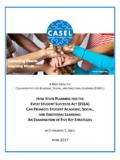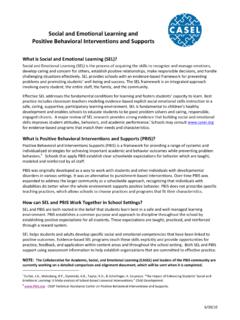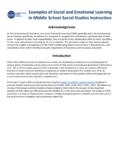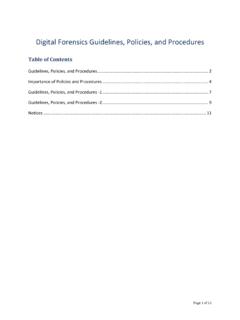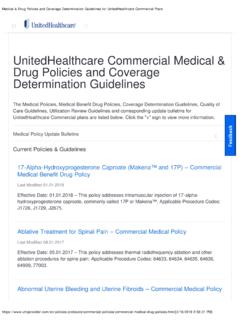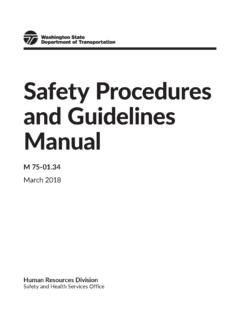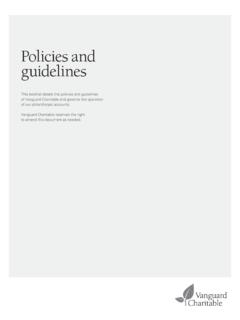Transcription of Key Features of High Quality Policies and Guidelines ...
1 Key Features of high - Quality Policies and Guidelines to Support Social and Emotional Learning Recommendations and Examples for the Collaborating States Initiative (CSI) By Linda Dusenbury and Nick Yoder January 2017 The current document serves two purposes. First, it provides an overview of six key Features of a high - Quality , comprehensive package of Policies and guidance to support student social and emotional learning (SEL). These Features are based on Collaborative for Academic Social, and Emotional Learning s (CASEL s) review of the research literature on learning standards and SEL as summarized in Dusenbury et al. (2015).1 The six key Features represent Policies and guidance that are comprehensive and robust in that they are culturally and linguistically sensitive and developmentally appropriate, as well as connected to positive learning environments and professional development (Figure 1 gives an overview of the six key Features ).
2 Second, this document provides examples from other states and districts that illustrate each of the key Features of high - Quality Policies and guidance for SEL. How to Use This Document This document is intended for state education agencies (SEAs) that want to implement high - Quality Policies and Guidelines for SEL. This document is intended to help SEAs identify the key Features of SEL Policies and Guidelines , as well as associated example resources from other states or districts that implement SEL Policies and Guidelines . The intention of this document is to provide information about what makes high - Quality Policies and Guidelines , and it should be used in combination with process documents as the SEA thinks about how to develop, disseminate, and implement SEL Policies and Guidelines ( , The CSI Recommended Process for Developing State Policies and Guidelines to Support Social and Emotional Learning).
3 Contact consultants at CASEL or AIR for further information and support. Linda Dusenbury is a senior research scientist at the Collaborative for Academic Social, and Emotional Learning (CASEL), and Nick Yoder is a senior consultant and researcher at American Institutes for Research (AIR). 1 Dusenbury, L., Zadrazil, J., Weissberg, R. P., Goren, P., Domitrovich, C., & Mart, A. (2015). Developing a blueprint for education in social and emotional learning, preschool through high school: The case for state learning standards. In J. A. Durlak, C. E. Domitrovich, R. P. Weissberg, & T. P. Gullotta (Eds.), Handbook of social and emotional learning: Research and practice. New York, NY: Guilford. Copyright 2016 American Institutes for Research, and Key Features of high - Quality Policies and Collaborative for Academic, Social, and Emotional Learning. Guidelines to Support SEL 1 All rights reserved.
4 7682_11/16research, about what students should know and be able to do socially and emotionally. Figure 1. Key Features of high - Quality Policies and Guidelines for SEL 1. Clearly stated, freestanding learning goals with age-appropriate benchmarks to articulate goals for student SEL, preschool through high school. 4. Include Guidelines on how to create positive learning environment. 2. Are integrated and aligned with academic content standards. 5. Are culturally and linguistically appropriate. 3. Incorporate Guidelines about teacher practices that support social and emotional development. 6. Link to strategies and tools to enhance implementation. 1. Clearly stated, freestanding learning goals with age-appropriate benchmarks for student SEL, preschool through high school. To support student development, it is important to have a clear definition of the competencies and skills students should develop across grade levels.
5 One approach is to first begin by defining clear, freestanding. and comprehensive, learning goals for student social and emotional competencies. Identifying these learning goals (sometimes called competencies or standards in state and district policy) is important because they establish social and emotional development as a clear priority in education, aligned with but distinct from academic and subject matter goals ( , freestanding). Comprehensive learning goals for SEL include developmental benchmarks across five social and emotional competency domains (self-awareness, self-management, social awareness, relationship skills, and responsible decision-making skills). high - Quality , freestanding SEL goals or competencies provide concise, consistent statements, grounded in American Institutes for Research, and Key Features of high - Quality Policies and Collaborative for Academic, Social, and Emotional Learning.
6 Guidelines to Support SEL 2 SEL Standards Examples Link Anchorage School District K 12 SEL Standards and Indicators ents/ Austin Independent School District SEL Standards Cleveland SEL Scope and Sequence 4/Centricity/shared/districtfiles/depart ments/humanware/SEL %20 Scope%20and% Illinois Preschool Standards (start on page 93) Illinois K 12 SEL Standards and Performance Indicators Kansas SECD Standards (SEL and Character Development) Services/Career-Standards-and-Assessment - Services/Content-Area-M-Z/School-Counsel ing/Social- Emotional-and-Character-Development West Virginia K 12 SEL Standards #SelfawarenessandSelfmanagement support of each other in a young person s life. 3. Incorporate Guidelines about teacher practices that support social and emotional 2. Are integrated and aligned with academic content standards.
7 SEL competencies are similar to, but distinct from academic content standards. They are similar in that they provide learning goals for students across grade bands, and identify milestones for students to reach. However, they are different given that the development of social and emotional competencies are recursive in that we constantly relearn and apply these competences across the lifespan. In addition, an individuals use of their social and emotional competencies can be dependent on the context in which he/she is in and the culture in which one is situated. Social and emotional competencies are about self development, related to academic achievement, enabling students to develop the skills they need to be successful in school, career, and life. Thus, social and emotional goals should be integrated and aligned with academic goals in development. Educators can support student social and emotional development in many ways, through SEL programs as well as through the general instruction that occurs throughout the school day.
8 To support implementation, states and districts should provide guidance on how adults can support student social and emotional development through teaching practices and ways in which administrators can support teachers in implementing those practices. It is also important to help teachers reflect upon and develop their own social and emotional competencies. American Institutes for Research, and Key Features of high - Quality Policies and Collaborative for Academic, Social, and Emotional Learning. Guidelines to Support SEL 3 Integrated Academic and Subject Area Examples Link Video on SEL and Common Core from Anchorage School District chsch&eID=55 Oakland Unified School District s alignment of SEL and Common Core content/uploads/2015/07 Kansas Crosswalk to College and Career Readiness Standards (M- Z)/School%20 Counseling/Soc_Emot_Char_Dev/SECD%20 Alig ned%20to%20 CCR% West Virginia Crosswalk Idaho Crosswalk With Early Childhood ddlerProgram/ Adult Teaching Practices Examples Link Incorporating Social and Emotional Learning Into Classroom Instruction and Educator Effectiveness: A Toolkit for Tennessee Teachers and Administrators Tennessee SEL Online Learning Modules Forthcoming Center on Great Teachers and Leaders SEL School Center on Great Teachers and Leaders.
9 Teaching the Whole Child 4. Include Guidelines on how to create a positive learning environment. Positive learning on how SEL contributes to conditions for learning and conditions for teaching. environments are critically important to the development of student and adult social and emotional competencies. When students learn and educators work in an environment that is safe, supportive, and connected, students and adults are more likely to develop the social and emotional competencies they need to be successful. It is therefore critical to provide guidance 5. Are culturally and linguistically appropriate. Social and emotional behaviors are mediated though an individual s social and cultural lens, including his or her cultural histories, practices found within his or her communities, and his or her person identities. It is thus important to recognize the influence culture has on ways in which we use our social and emotional competencies.
10 When developing SEL Guidelines and Policies , states and districts should incorporate guidance on how to make SEL instruction and practice culturally sensitive and linguistically appropriate so that practices do not further contribute to or support stereotypes. It is important for educators to recognize their own cultural lens, and to also respect and support the cultural experience of their students. For example, cultures differ in their communication styles, making it important to consider the culture of students when helping them to develop communication skills that will be effective in different contexts. American Institutes for Research, and Key Features of high - Quality Policies and Collaborative for Academic, Social, and Emotional Learning. Guidelines to Support SEL 4 Development of a Positive School Climate Examples Link Department of Education s School Climate Improvement Resource Package Ohio School Climate Guidelines elines National Center on Safe and Supportive Learning Environments California Discussion of Well- Designed Environment (Preschool) (beginning on page 4) Illinois Example for Creating a Positive Learning Environment (K 12) Massachusetts Educator Effectiveness Guidebook for Inclusive Practice (UDL, SEL, and PBIS) Kansas Instructional Examples: Personal Development (M- Z)/School%20 Counseling/Soc_Emot_Char_Dev/PersonalDev _ Kansas Instructional Examples.
